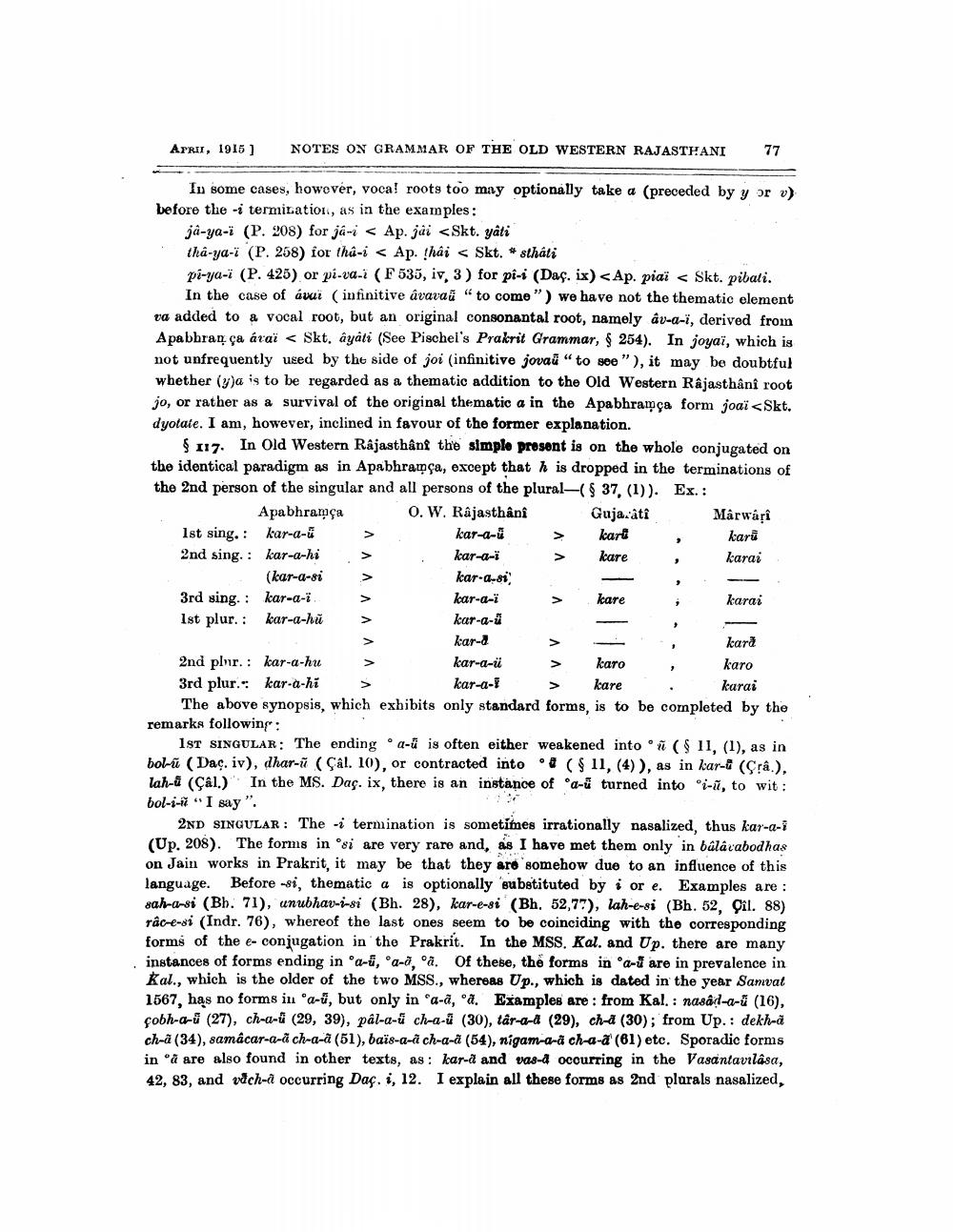________________
Arrir, 1916)
NOTES ON GRAMMAR OF THE OLD WESTERN RAJASTHANI
77
A
A
Iu some cases, however, vocal roots too may optionally take a (preceded by y or v) before the -i termination, as in the examples:
ja-ya-ï (P. 208) for já-i < Ap. jäi <Skt. yati tha-ya-7 (P. 258) for tha-i < Ap. thái < Skt. #sthati pi-ya-ï (P. 425) or pi-va- (F 535, iv, 3) for pi-i (Daç. ix) <Ap. piai < Skt. pibali.
In the case of avai (infinitive avavaữ "to come") we have not the thematic element ta added to a vocal root, but an original consonantal root, namely av-a-i, derived from Apabbran, ça áraï < Skt. âyâti (See Pischel's Prakrit Grammar, $254). In joyaï, which is not unfrequently used by the side of joi infinitive jovaữ “to see"), it may be doubtful whether (y)a is to be regarded as a thematic addition to the Old Western Rajasthani root jo, or rather as a survival of the original thematic a in the Apabhramça form joai <Skt. dyolate. I am, however, inclined in favour of the former explanation.
$117. In Old Western Rajasthant the simple present is on the whole conjugated on the identical paradigm as in Apabhrapça, except that his dropped in the terminations of the 2nd person of the singular and all persons of the plural-($ 37, (1)). Ex.:
Apabhramça 0. W. Rajasthani Guja.âtî Marwari 1st sing.: kar-a- kar-a- > kari
karū 2nd sing. : kar-a-hi kar-a-7 > kare
karai (kar-a-si
kar-a-81) 3rd sing. : kar-a-i.
kar-a-z
kare
karai 1st plur. : kar-a-hů
kar-a-1 kar-1
kara 2nd plur. : kar-a-hu
kar-a-ü
karo
karo 3rd plur.: kar-a-hi
kar-a-1 > kare , kurai The above synopsis, which exhibits only standard forms, is to be completed by the remarks following:
IST SINGULAR: The ending oa-u is often either weakened into ($11. (1), as in bol-(Daç. iv), dhar-u (Çal. 10), or contracted into • ($ 11, (4), as in kar- (Crâ.), lah-a (Çal.)"In the MS. Dag. ix, there is an instance of a-u turned into i-ū, to wit: bol-3-77 " I say ".
2ND SINGULAR: The -i termination is sometimes irrationally nasalized, thus kar-a-1 (Up. 208). The forms in si are very rare and, as I have met them only in bûlavabodhas on Jain works in Prakrit, it may be that they are somehow due to an influence of this language. Before -si, thematic a is optionally substituted by i ore. Examples are : sahra-si (Bh. 71), anubhav-3-si (Bh. 28), kar-e-8i (Bh. 52,77), lah-e-si (Bh. 52. Çil. 88) râc-e-si (Indr. 76), whereof the last ones seem to be coinciding with the corresponding forms of the e- conjugation in the Prakrit. In the MSS. Kal. and Up. there are many instances of forms ending in a-u, a-3, a. Of these, the forms in a-1 are in prevalence in Kal., which is the older of the two MSS., whereas Up., which is dated in the year Samvat 1567, has no forms in a-u, but only in a-a, a. Examples are : from Kal.: nasád-a-ů (16), çobh-a-ü (27), ch-a-ü (29, 39), pal-a-ú ch-a-1 (30), târ-a-a (29), ch-4 (30); from Up.: dekh-a ch-a (34), samacar-a-ì ch-a-a (51), baïs-a-i ch-a-a (54), nigam-a-a ch-a-a (61) etc. Sporadic forms in å are also found in other texts, as : kar-d and vas-4 ocourring in the Vasantavilása, 42, 83, and vdch-à occurring Dac. i, 12. I explain all these forms as 2nd plurals nasalized,
V V V V V V V V
A




